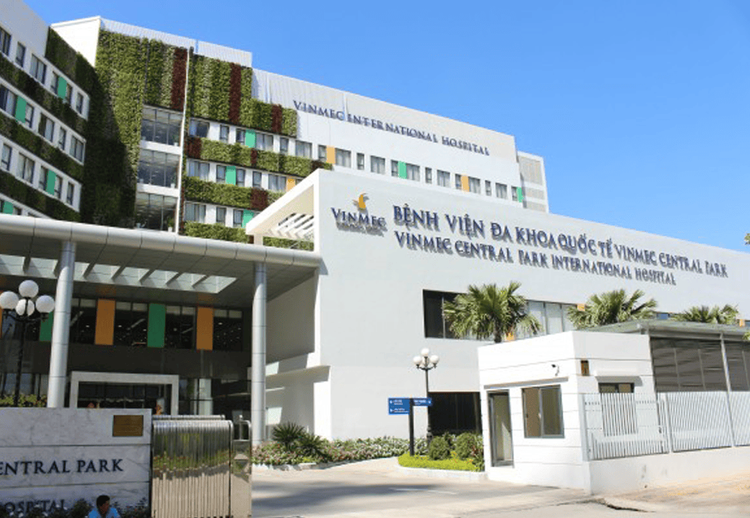This is an automatically translated article.
Uterine cancer is the second most common female cancer in the world, after breast cancer. Cervical cancer radiation therapy is a treatment measure to destroy cancer cells, increase the possibility of cure or minimize the side effects of the treatment method.1. What is uterine cancer?
Normally, the uterine cavity is covered with a layer of mucosa separating it from the muscular layer of the uterus, so it is also called the endometrium. This lining is subject to the action of estrogen during a woman's menstrual cycle. Every month, under the effect of estrogen in the ovary, this lining grows so that at the end of the menstrual cycle due to a decrease in estrogen, this mucosal layer sheds to form menstruation. Thus, this mucosal layer is only present in the uterine cavity.Uterine cancer, also known as endometrial cancer, is a type of cancer in the uterus. Endometrial cancer begins in the cell layer of the endometrium. Other types of cancer can form in the uterus, including uterine sarcoma, but they are much less common than endometrial cancer.
Endometrial cancer is often detected in its early stages because it often causes abnormal vaginal bleeding. If endometrial cancer is found early, surgical hysterectomy usually cures endometrial cancer.
2. Symptoms of uterine cancer
Vaginal bleeding after intercourse. Menstruation is longer and more frequent than usual. Vaginal bleeding outside of menstrual period. Women who have stopped menstruating have vaginal bleeding (although very little bleeding). Pain in the lower abdomen (no period). White bleeding.
Đau vùng bụng dưới dù không trong kỳ kinh nguyệt là triệu chứng của ung thư tử cung
3. Causes of uterine cancer
Doctors still don't know what causes uterine cancer. What is known is that something causes mutations in the DNA of cells in the endometrium - the lining of the uterus. This mutation turns normal, healthy cells into abnormal cells. Healthy cells grow and multiply at a fixed rate, eventually dying in a programmed time. However, the abnormal cells grow and multiply out of control and they do not die at a set time. Abnormal cells accumulate to form a tumor. Cancer cells that invade nearby tissues and can break away from an original tumor to spread elsewhere in the body are called metastases.4. Treatment of uterine cancer
Treatment for uterine cancer is usually with surgery to remove the uterus, fallopian tubes, and ovaries. Another option is radiation therapy, which uses high-energy rays to kill cancer cells. Drug treatment for uterine cancer includes chemotherapy with strong drugs and hormone therapy to block the hormones that cause cancer cells to continue to grow. Other options include targeted therapy with drugs that attack specific weaknesses in cancer cells and immunotherapy to help a person's immune system fight the cancer.
Có thể điều trị bằng phương pháp điều trị đích với các loại thuốc tấn công vào điểm yếu cụ thể của tế bào ung thư
5. Radiation therapy for uterine cancer
The goal of radiation therapy is to kill uterine cancer cells to increase the likelihood of a cure or maximum relief from the side effects of the treatments. Radiation therapy may be used to prevent local recurrence of cancer after surgery or to treat cancer that has recurred. Radiation is usually used in the form of high-dose beams of radiant energy into the body where cancer cells are located. Radiation therapy, unlike chemotherapy, is a topical treatment. Cancer cells can only be destroyed when radiation is delivered to the right location, if the cancer exists outside the radiation field, the cancer cells will not be destroyed by the radiation rays. Therefore, radiation therapy is often used for early-stage cancers because the cancer area is limited to one location in the body.Radiation therapy (Brachytherapy) is a procedure that involves placing radioactive material inside the body also known as internal radiation. Brachytherapy allows doctors to deliver higher doses of radiation to specific areas of the body, compared to conventional forms of radiation therapy (external beam radiation) which project radiation from a machine. outside of the body. Brachytherapy may cause more side effects than external beam radiation and the overall treatment time is usually shorter with brachytherapy.
5.1 Radiation therapy for patients with uterine cancer Modern radiation therapy for uterine cancer is performed using a linear accelerator, which generates high-energy external beams of radiation through the tissues. tissue and deliver radiation doses deep into the cancerous area. These state-of-the-art machines and other advanced techniques have allowed oncologists to reduce unnecessary radiation, thus significantly reducing the side effects of radiation therapy while improving delivery. Maximize radiation dose to areas with cancer cells and reduce damage to normal tissues.
5.2 Schedule of Treatment A typical course of radiation therapy for someone with uterine cancer will require radiation treatment every day, Monday through Friday, for 3 to 5 weeks. The actual treatment with radiotherapy usually lasts no more than a few minutes, during which time the patient hardly feels any discomfort. Anesthesia is not required for the patient for radiation treatment. Many patients continue to work during the weeks of treatment.
5.3 Side effects and complications of radiation therapy
The vast majority of patients can complete radiation therapy for uterine cancer without much difficulty. Side effects and potential complications of radiation therapy are rare and when they do are usually limited to the area being treated with radiation. However, side effects vary from patient to patient, and some people may feel them while others may not. If side effects occur, patients should notify technicians and treating doctors to handle and minimize side effects for patients.
Radiation therapy to the abdomen/pelvic area may cause diarrhea, abdominal cramps, or increased frequency of bowel movements or urination. These symptoms are usually temporary and will go away once a course of radiation is completed. Occasionally, abdominal cramps may be accompanied by nausea.
Blood count may be affected by radiation therapy. In particular, white blood cell and platelet counts may be reduced. This depends on the bone marrow level and whether the patient has had or is receiving chemotherapy. Changes in cell counts are usually not significant and may improve after radiation is completed. In addition, patients should be aware of changes in sleep or rest patterns while they are receiving radiation therapy and some patients feel fatigued and exhausted.
Late complications are rare after radiation therapy for uterine cancer. Potential complications include bowel obstruction, ulcers, or radiation-induced cancer. Radiation to the pelvis also increases the risk of lymphedema of the lower body.
Therefore, to improve the quality of life, improve the quality of treatment, and limit complications for patients with uterine cancer is essential. Patients should choose medical facilities with a team of good oncologists and radiotherapy technicians with many years of experience. Besides, in addition to the medical staff, the use of modern radiotherapy machines also plays a huge part in the success of uterine cancer treatment. In Vietnam, there are many cancer treatment facilities that meet the above criteria, including Vinmec Hospital.
6. Why choose radiation therapy for uterine cancer at Vinmec Central Park hospital?

Trung tâm Ung bướu Vinmec Central Park có nhiều ưu điểm vượt trội trong điều trị ung thư
Vinmec Convergence of experts who are good at radiation therapy, chemotherapy and surgery, equipped with modern facilities. The most modern radiotherapy planning system and Truebeam in Southeast Asia, with the outstanding advantage of minimizing the effects of radiation on benign tissues compared to X-rays, reducing irradiation time and the risk of adverse effects. side effects for patients.) helps effectively treat common cancers: Lung, Head, neck, breast, etc. As the first hospital in Ho Chi Minh City to apply autologous immunotherapy, Vinmec Hospital Central Park can treat cancer with multimodal cancer treatment protocols suitable for each case, bringing high treatment efficiency, providing an additional reliable cancer examination and treatment address for people. To learn more about radiation therapy for cancer treatment at Vinmec, you can contact HOTLINE or register online HERE
Please dial HOTLINE for more information or register for an appointment HERE. Download MyVinmec app to make appointments faster and to manage your bookings easily.
References: Cancer.org; Mayoclinic.org and Taxasoncology.com












